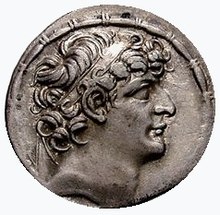
Back فيليب الأول (فيلاديلفوس) Arabic فيليب الاول (ملك) ARZ بیرینجی فیلیپ سلوکی AZB Філіп I Філадэльф Byelorussian Филип I Филаделф Bulgarian Filip I Filadelf Catalan Filip 1. af Seleukideriget Danish Philipp I. Philadelphos German Φίλιππος Α΄ Φιλάδελφος Greek Filipo I Filadelfo Spanish
| Philip I Philadelphus | |
|---|---|
 Philip I's portrait on the obverse of a tetradrachm | |
| King of Syria | |
| Reign | 94–83 or 75 BC |
| Predecessor | Seleucus VI, Demetrius III, Antiochus X |
| Successor | Antiochus XIII, Cleopatra Selene |
| Born | between 124 and 109 BC |
| Died | 83 or 75 BC |
| Issue | Philip II |
| Dynasty | Seleucid |
| Father | Antiochus VIII |
| Mother | Tryphaena |
Philip I Epiphanes Philadelphus (Ancient Greek: Φίλιππος Ἐπιφανής Φιλάδελφος; between 124 and 109 BC–83 or 75 BC) was a Hellenistic Seleucid monarch who reigned as the king of Syria from 94 to either 83 or 75 BC. The son of Antiochus VIII and his wife Tryphaena, he spent his early life in a period of civil war between his father and his uncle Antiochus IX. The conflict ended with the assassination of Antiochus VIII; Antiochus IX took power in the Syrian capital Antioch, but soon fell in battle with Antiochus VIII's eldest son Seleucus VI.
After the murder of Seleucus VI in 94 BC, Philip I became king with his twin brother Antiochus XI, and planned to avenge Seleucus VI. In 93 BC Antiochus XI took Antioch from Antiochus IX's son Antiochus X. Antiochus XI became the senior king, and Philip I remained in a base in Cilicia. Antiochus X returned and killed Antiochus XI that year. Philip I then allied with his younger brother Demetrius III, who was based in Damascus. Antiochus X was probably killed in 88 BC. Demetrius III took the capital and besieged Philip I in Beroea (Aleppo), but the latter prevailed and took Antioch; their youngest brother Antiochus XII took Damascus.
Philip I tried unsuccessfully to take Damascus for himself, after which he disappears from the historical record; there is no information about when or how he died. The Antiochenes, apparently refusing to accept Philip I's minor son Philip II as his successor, invited Tigranes II of Armenia to take the city. While the invasion of Tigranes II is traditionally dated to 83 BC, the year most scholars agree on for Philip I's death, the conflict may have taken place in 74 BC. Numismatic evidence and clues in ancient contemporary literature indicate that Philip I might have died in 75 BC, giving Antiochus X's widow Cleopatra Selene and her son Antiochus XIII, who probably took control of the south following the death of Antiochus XII in 82 BC, a year of claiming the whole kingdom. Philip I initiated monetary reforms, and his coins remained in circulation until the Romans conquered Syria in 64 BC. Thereafter, Roman authorities in Syria continued to issue coins modeled on Philip I's coins, including his portrait, until 13 BC.
© MMXXIII Rich X Search. We shall prevail. All rights reserved. Rich X Search